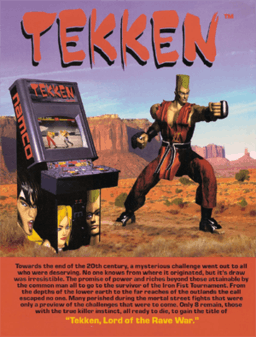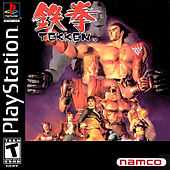Tekken (video game)
| Tekken | |
|---|---|
 Front side of North American Tekken arcade flyer | |
| Developer(s) | Namco |
| Publisher(s) | Namco |
| Director(s) | Seiichi Ishii |
| Producer(s) | Hajime Nakatani |
| Designer(s) | Seiichi Ishii |
| Composer(s) | Yoshie Arakawa Yoshie Takayanagi |
| Series | Tekken |
| Platform(s) | Arcade, PlayStation, PlayStation 2 (as part of Tekken 5 's Arcade History mode), PlayStation Network |
| Release date(s) | Arcade PlayStation JP March 31, 1995 EU November 7, 1995 NA November 8, 1995 PAL May 21, 2011 (PSN) NA June 3, 2011 (PSN) JP July 6, 2011 (PSN) |
| Genre(s) | Fighting |
| Mode(s) | Up to two players |
| Cabinet | Upright |
| Arcade system | Namco System 11 |
Tekken is a fighting game and is the first of the series. It was released at arcades in late 1994 and on the PlayStation in 1995. It was developed and published by Namco. It is succeeded by Tekken 2, which came out in 1995.
Gameplay
Tekken is one of the earliest 3D fighting game franchises, with the first game applying many of the concepts found in Virtua Fighter by Sega. As with many fighting games, players choose a character from a lineup, and engage in hand-to-hand combat with an opponent.
Unlike most fighting games of the time, Tekken allows the player to control each of the fighter's four limbs independently.[1] The player can watch the animation on screen and figure out the appropriate command (if the character kicks low with their right leg, the move is likely to be executed by pressing down and right kick, or a similar variation).
By default, there are two rounds of combat. However, the players have a choice from one to five rounds, as well as options for the time limit of each round. If the time limit for the round expires, the character with more health remaining will be declared the winner. If one does not exist, the round will be a draw.
In the game, the name of the location is displayed in the bottom right corner of the screen. The locations are all real places and included Angkor Wat (Cambodia), Szechwan (China), Monument Valley (USA), Chicago (USA), Kyoto (Japan), Fiji, Windermere (Great Britain), Venezia (Italy), Acropolis (Greece), King George Island (Antarctica), and Chiba Marine Stadium (Japan).
Plot
Heihachi Mishima, the powerful and ruthless owner of the Mishima Zaibatsu conglomerate, announces the King of the Iron Fist Tournament, a fighting tournament with a one billion dollar cash prize to the winner. One competitor from within the tournament is Kazuya Mishima, Heihachi's estranged son who has entered for revenge against his father.
When Kazuya was only five years old, Heihachi had carried him to the top of a mountain and callously threw him off a cliff to test his son's strength and see if he would be able to climb back up the same cliff (this test would determine on whether or not Kazuya was worthy to be Heihachi's heir so that he would be able to inherit the Mishima Zaibatsu one day from within the future). Kazuya survived the initial fall, but with a large scar on his chest, this caused the Devil gene to activate that he inherited from his mother, offering Kazuya the opportunity to gain immense strength and power so that he can have his revenge against Heihachi, driven by anger and hatred while having with life-threatening wounds, he climbed back up.
The King of the Iron Fist Tournament takes place twenty-one years later, and by now Kazuya is an undefeated fighting champion (the only blemish on his record is a draw against Paul Phoenix: an American martial artist who seeks to settle the score with Kazuya while hoping to win the tournament at the same time). Kazuya enters the tournament and ultimately makes it to the final round, where Heihachi awaits him, angry and furious to know of his estranged son's winnings.
Kazuya and Heihachi clash in battle atop the same cliff from which Heihachi tossed Kazuya years earlier until Kazuya, now powered by the strength given to him by the Devil, overpowers Heihachi and beats him into an unconscious state. Kazuya picks up his father's body and drops him from the cliff. Smiling to himself, Kazuya becomes the owner of the Mishima Zaibatsu.
Characters
The original arcade version has eight characters available by default. Each character has a "sub-boss", a special character that was fought on Stage 8. The sub-bosses were clones in term of movesets (they generally share the same moveset as the original character with few exclusive attacks). Heihachi, the main antagonist serves as the final boss for the game. All sub-bosses and Heihachi are not playable in the arcade version. When the game was ported to PlayStation, all sub-bosses and Heihachi were made playable. Also, Kazuya's alter-ego, Devil, was made available as an unlock for completing the Galaga-based minigame. The unlockable characters are only playable in the PlayStation version.
The characters are:
|
Anna Williams (Nina's sub-boss) (console playable, unlockable) |
Ganryu (Yoshimitsu's sub-boss) (console playable, unlockable) |
Development
Tekken was not originally conceived as a fighting game. The project began as an internal Namco test case for animating 3D character models, and eventually incorporated texture mapping similar to that found in Namco's 1993 racing game Ridge Racer.[2] In 1994, Namco acquired developers from longtime competitor Sega, which had recently created the first 3D fighting game with 1993's Virtua Fighter.[3][4] Directed by Virtua Fighter designer Seiichi Ishii, Tekken was intended to be a fundamentally similar title, with the addition of detailed textures and twice the frame rate.[2] Tekken was further distinguished by its intuitive control scheme and memorable characters.[5] Because it was developed for Namco's System 11 arcade board, which was based on raw PlayStation hardware, Tekken was easily ported to the latter.[3][6] It was the first arcade game to use this board.[1] Tekken was marketed to small arcades as a cheaper alternative to Sega's Virtua Fighter 2, which was released for the more expensive Model 2 arcade board.[6]
Music
The music in Tekken was composed by Yoshie Arakawa and Yoshie Takayanagi.
Release

Tekken was later ported to the PlayStation. The PlayStation version allowed players to unlock mid-boss characters when the game was beaten and had FMVs.
The PlayStation 2 version of Tekken 5 features the arcade version of Tekken (being an emulated version of its arcade counterpart as well as the other two that were included in the arcade history mode). In 2005, Namco re-released Tekken as part of the NamCollection compilation for the PlayStation 2 to celebrate the company's 50th anniversary.
Reception
| Reception | ||||||||||
|---|---|---|---|---|---|---|---|---|---|---|
| ||||||||||
On release, Famicom Tsūshin (now Famitsu) scored Tekken a 38 out of 40,[7][8] giving it an 8 out of 10 in their Reader Cross Review.[10] Edge gave it a 9 out of 10, stating that, despite "lacking the overall visual allure" of Virtua Fighter 2, Tekken "not only matches" the "style and quality of Sega’s character animation, but it pushes its rival to the wire in playability terms, too."[6] The game was met with many positive reviews, with critics claiming it was a good start to the series. Its success and popularity has spawned six sequels and three spin-offs. The Tekken games have been highly popular with the martial arts community due to moves of the fighters being close to the actual style of fighting.
Tekken was a bestseller in the UK.[11] The game was the first PlayStation game to sell over a million units.[12]
Guinness World Records awarded Tekken with multiple records in the Guinness World Records Gamer's Edition 2008. These include, "First PlayStation Game to Sell Over One Million Units", "First Fighting Game To Feature Simulated 3D", as well as a record for the entire series as "The Best Selling Fighting Series for PlayStation Consoles."
References
- ↑ 1.0 1.1 "Tekken". GamePro (68) (IDG). March 1995. p. 38.
- ↑ 2.0 2.1 "An Audience With: Katsuhiro Harada – on 20 years of Tekken and the future of fighting games". Edge. 2013-09-23. Retrieved 2014-11-21.
- ↑ 3.0 3.1 "Namco". Next Generation 1 (1): 70–73. January 1995.
- ↑ Leone, Matt. "The Essential 50: Virtua Fighter". 1UP.com. Retrieved 2014-11-21.
- ↑ Mott, Tony (2013). 1001 Video Games You Must Play Before You Die. New York, New York: Universe Publishing. p. 254. ISBN 978-0-7893-2090-2.
- ↑ 6.0 6.1 6.2 6.3 "Tekken". Edge 3 (21): 66–70. June 1995.
- ↑ 7.0 7.1 NEW GAMES CROSS REVIEW: 鉄拳. Weekly Famicom Tsūshin. No.330. Pg.30. 14 April 1995.
- ↑ 8.0 8.1 PLAYSTATION CROSS REVIEW: 鉄拳. Weekly Famicom Tsūshin. No.333. Pg.21. 5 May 1995.
- ↑ "Tekken Review". IGN. 1996-10-26. Retrieved 2008-10-04.
- ↑ 読者 クロスレビュー: 鉄拳. Weekly Famicom Tsūshin. No.335. Pg.30. 12–19 May 1995.
- ↑ Gallup UK Playstation sales chart, January 1996
- ↑ Playstation History - Playstation Frequently Asked Questions in Absolute Playstation
External links
- Official website (Japanese)
- Tekken page at Tekkenpedia
| ||||||||||||||||||||||||||||||||||||||||||